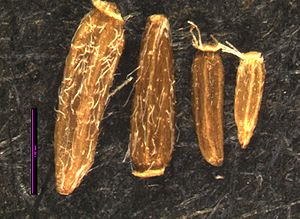Solidago lepida
- Scientific Name: Solidago canadensis
- Family: Asteraceae
- English Names: Canadian goldenrod
Contents
Taxonomy
- Kingdom: Plantae
- (unranked): Angiosperms
- (unranked): Eudicots
- (unranked): Asterids
- Order: Asterales
- Family: Asteraceae
- Tribe: stereae
- Genus: Solidago
- Species: S. canadensi
Description
At a Glance: Forms patches from long creeping rhizomes. Stems leafy and hairy near the top, with a dense cluster of small yellow flowers.
Height: Up to 5 feet (1.5 meters).
Growth Form: Herb.
Stems: Leafy stems, hairy on upper portions.
Leaves: Lacking basal leaves; stem leaves numerous and crowded, gradually reduced upwards; saw-toothed to entire; hairless to roughly hairy on upper and lower sides; leaves are prominently 3-veined;
shape: lance-shaped to linear;
color: green. Flowers: Numerous flower heads in dense pyramidal cluster; ray flowers 10-17, 1-3 mm long; involucres 3-6mm x 3-5mm, long-pointed bracts that sometimes overlap, sometimes sticky and glandular.
Bloom Period
June, July, August, September.
Distribution
Across Canada and throughout the United States.
Habitat
Ecological Setting
Coastal bluffs, dunes or beaches; Open forests, Forest edges, openings, or clearings and thickets; Meadows or grassy areas; Prairie, Plains, Pastures, Savannahs, Stream banks, Roadsides and disturbed sites; low to mid elevations
Soil Texture
Coarse, medium, or fine.
Nutrients
Nutrient rich soil
Soil Reaction / Salinity
pH, Minimum 4.8 pH, Maximum 7.5
No salinity tolerance
Moisture Regime
Common in dry and moist habitats.
Shade Tolerance
Shade intolerant - mostly sunny 60%-80%
Uses
Wildlife
Birds: The seeds of goldenrod are eaten by numerous bird species.
Insects: The bright, showy flowers attract bumblebees and pine white, red admiral, and mylitta crescent butterflies. Syrphid flies and small wasps also frequently visit the goldenrod flowers.
First Nations
Infusion of roots and flowers used for side pains; Compound infusion of roots taken as an emetic and to kill a love medicine; Infusion of flowers taken as an emetic for too much gall; Plant used as a "gambling medicine"; Compound infusion of tubers given to babies that start suddenly during sleep; Compound decoction used as wash for child who does not talk or laugh; Infusion of flower heads taken for diarrhea; Infusion of shoots given to children with fevers; Decoction of flower heads taken for the flu; Infusion of blossoms used for special kinds of fevers; Infusion of plant used as a bath for the mother at childbirth; Decoction of plant used as a bath for babies with diarrhea, sleeplessness or excessive crying; Decoction of plant tops taken for diarrhea; Plant used to make a steambath for crippled, paralyzed people; Decoction of plant and wild tarragon used as a wash for horses with cuts and sores; Crushed blossoms chewed for sore throat; Infusion of crushed blossoms taken for body pain; Seeds used for food; Roots steeped or eaten; Roots smoked with other tobaccos; Clustered flower heads used by children as play whips.
Other
Haemostatic, styptic. The root is applied as a poultice to burns. An infusion of the dried powdered herb can be used as an antiseptic. The blossoms are analgesic, astringent and febrifuge.
A tea made from the flowers is used in the treatment of diarrhoea, body pains, fevers and snakebites.
The plant contains quercitin, a compound that is reportedly useful in the treatment of haemorrhagic nephritis. This plant is said to have similar medicinal properties to S. virgaurea. Goldenrod is a safe and gentle remedy for a number of disorders. In particular, it is a valuable astringent remedy treating wounds and bleeding, whilst it is particularly useful in the treatment of urinary tract disorders, being used both for serious ailments such as nephritis and for more common problems such as cystitis.
The plant contains saponins that are antifungal and act specifically against the Candida fungus which is the cause of vaginal and oral thrush. It also contains rutin which is used to treat capillary fragility, and phenolic glycosides which are anti-inflammatory. The leaves and flowering tops are anthelmintic, anti-inflammatory, antiseptic, aromatic, astringent, carminative, diaphoretic, mildly diuretic, febrifuge and stimulant.
A good vulnerary herb, it has also proved of value when used internally in the treatment of urinary infections, chronic catarrh, skin diseases, influenza, whooping cough, bladder and kidney stones etc. Due to its mild action, goldenrod is used to treat gastro-enteritis in children. It makes an excellent mouthwash in the treatment of thrush.
The plant is gathered in the summer and dried for later use. The seed is anticoagulant, astringent and carminative.
A homeopathic remedy is made from the plant. It is used in the treatment of kidney and bladder disorders, rheumatism and arthritis.
Goldenrod was reputedly carried into battle during the crusades and was often used as a substitute for highly taxed English tea during the American revolution. Goldenrod contains small amounts of rubber and Thomas Edison tried to make a business out of extracting rubber from inexpensive goldenrod. The yellow tops can be harvested and used to make a strong yellow or golden dye.
Propagation
Photo Gallery
- Solidago canadensis PID1502-1.jpg
- Solidago canadensis PID1502-3.jpg
References
Washington Native Plant Society
Wildflower Center: University Of Texas at Austin
http://herb.umd.umich.edu/herb/search.pl
Plants for a Future

